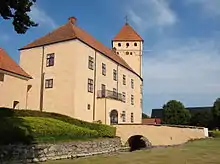Jørgen Thygesen Brahe
Jørgen Thygesen Brahe (Jørgen Brahe til Tostrup i Skåne) (1515 – June 21, 1565) was a member of the Danish nobility.[1]

Biography
He was the son of Danish Councillor Thyge Axelsen Brahe til Tostrup (d. 1523) and brother of privy council (Rigsraad) member Otte Brahe (1518–1571). He was married to Inger Johansdatter Oxe, sister of Peder Oxe (1520–1575), Steward of the Realm. His marriage was childless. He and his wife adopted his nephew, astronomer Tycho Brahe (1546–1601), when Tycho was two. He raised Tycho and provided him with an education. [2]
Jørgen inherited considerable wealth from his parents, which in terms of the social structure of the time made him eligible for a royal appointment as county sheriff. He was successively sheriff to Tranekjær (1542–49), Odensegaard (1549–52), Vordingborg Castle (1552–57), and finally (1555 until his death in 1565) to Queen Dorothea at Nykøbing Castle on Falster.[3] By inheritance and purchase, he acquired substantial properties located principally in Skåne, Lolland and Fyn. His principal residence was at Tosterup Castle (Tosterups slott) in Scania.[4][5]
During the Northern Seven Years' War, he distinguished himself in naval warfare. He was captured at the Battle of Øland (Slaget ved Øland) in 1564 in association with sinking of Makalös, the largest warship of the Baltic Sea . He later distinguished himself at the Battle of Rügen in June 1565. He died that same year from a disease he had contracted while rescuing King Frederick II of Denmark when his horse was thrown into the water at Højbro, the bridge leading over to Slotsholmen.[6]
References
- Leon Jespersen. Jørgen (Thygesen) Brahe (Den Store Danske, Gyldendal)
- "Otte Brahe til Knudstrup, 1518-71". Dansk biografisk Lexikon. Retrieved January 1, 2019.
- Bricka 1888, p.589
- Brahe, Tyge (Dansk biografisk Lexikon)
- Peder Oxe (Dansk biografisk Lexikon)
- Pierre Gassendi, Tycho Brahe, the man and his work (original in Latin by Pierre Gassendi, 1654, this book was translated into Swedish and commented by Wilhelm Norlind, 1951)
![]() This article contains content from the Owl Edition of Nordisk familjebok, a Swedish encyclopedia published between 1904 and 1926, now in the public domain.
This article contains content from the Owl Edition of Nordisk familjebok, a Swedish encyclopedia published between 1904 and 1926, now in the public domain.